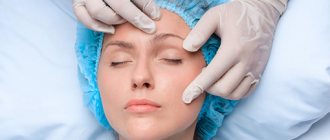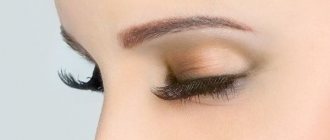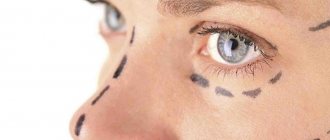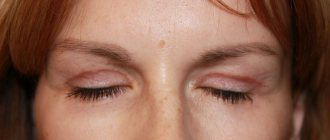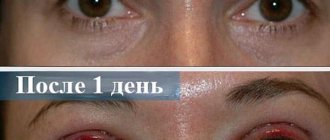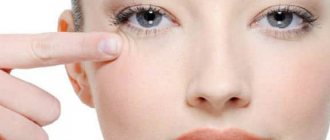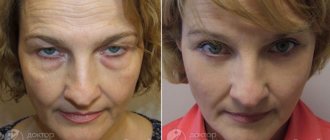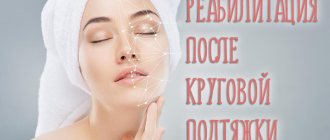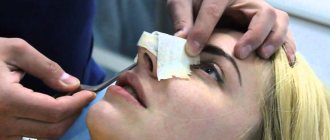The article presents step by step two periods of restoration of the eyelid structure after blepharoplasty of the upper and lower eyelids by day.
You will become familiar with the changes that occur on the facial skin in the first days after surgery, what can and cannot be done in the postoperative period, and also gain an understanding of tissue restoration procedures using massage and cosmetic procedures. Blepharoplasty is a rather exciting operation, since surgical changes are made on the face - the very first place that other people's eyes fall on.
With the right choice of clinic and a responsible approach from medical specialists, rehabilitation after blepharoplasty of both the upper and lower eyelids normally lasts from one to two weeks.
Timing and features of rehabilitation after eyelid blepharoplasty
By rehabilitation after circular blepharoplasty, doctors mean the time required for complete healing of the sutures, the disappearance of swelling and bruises. It includes various activities: lifestyle adjustments, use of medications, massage, physiotherapy, eye gymnastics.
The recommendations given by the doctor will certainly help shorten the recovery time after blepharoplasty, but in the first days the patient will be bothered by such negative manifestations as:
- pain symptoms;
- dry eyeball;
- feeling of “heavy eyelids”.
As a natural process characteristic of serious injuries, increased swelling and cyanosis will occur. Some of the symptoms can be relieved with medications, while others will just have to be waited out.
Patients are most interested in the question of how long rehabilitation after blepharoplasty lasts. The recovery period proceeds in different ways. For some it takes 2 weeks, and for others it will take 2 months to completely get rid of the consequences of the operation. It all depends on several factors:
- the age of the patient (after 45-50 years, the healing process of the skin is slower);
- skin type (wounds on oily skin heal faster, with dry skin and thick skin the process slows down);
- the structure of tissues in the eye area (if the vessels are close together, the recovery time is delayed).
Swelling, as a rule, goes away within 7-10 days; after 2-3 weeks there are no traces of bruises. It may take 10-12 weeks for scars to fade. Practice shows that a month after the operation, most scars become invisible, and only the paternal ones, located in the outer part of the eye, take longer to heal.
For patients with abnormally slow healing of sutures, doctors advise revision of the scars to prevent the proliferation of connective tissue.
Indications and contraindications
Blepharoplasty can be performed at any age.
Indications for performing the procedure are as follows:
- excess skin folds around the eyes;
- drooping corners of the eyelids;
- "tired eyes" syndrome;
- wrinkles;
- drooping of the eyelid over the eye;
- too narrow eye shape;
- extensive bags under the eyes.
Positive results are achieved provided that the rules of the rehabilitation period are followed 2-3 weeks after surgery.
Blepharoplasty has a number of limitations:
- Blepharospasm;
- Acute eye diseases;
- Chronic diseases of the sebaceous glands;
- Exacerbation of conjunctivitis;
- Glaucoma;
- Dry eye syndrome;
- Diabetes;
- Blood clotting disorder;
- Heart diseases;
- Oncological diseases;
- Hepatitis "A" and "B";
- HIV infection, AIDS.
It is strictly not recommended to perform blepharoplasty during pregnancy, lactation and menstruation in women.
Don't miss the most popular article in the section: Hyaluronic acid in tablets. Benefits, how to take, reviews from doctors and effectiveness.
Nuances of recovery by type of operation
The skin around the eyes has a thin structure, so regardless of the type of blepharoplasty surgery, it heals well. There are differences in terms:
- With blepharoplasty of the upper and lower eyelids, rehabilitation can take 5-12 days. The time frame may increase if general anesthesia was used.
- Most patients tolerate transconjunctival surgery easily. Traces of it are less noticeable due to the fact that the incisions are made on the mucous membrane on the inside of the eyelids. Some discomfort occurs when processing sutures, but in general, rehabilitation after transconjunctival blepharoplasty does not take much time.
- Minimally invasive laser blepharoplasty is performed with minimal disruption of the skin. Recovery is faster and there are fewer negative symptoms.
- Injection, in which skin rejuvenation is carried out by introducing special compounds, has the fastest recovery period.
It should be understood that the type of surgery performed depends on the severity of the changes. For example, with severe drooping eyelids, classical excision of excess skin and a circular lift help. Laser blepharoplasty can help eliminate small bags or hernias. If you want to get rid of crow's feet, you can use anti-aging injections. In any case, the decision to undergo surgery should be a joint decision between the doctor and the patient.
How to coat seams
During the recovery period, the sutures are tightened after 10-12 days; in order for them to heal well, it is necessary to perform special exercises, do physical procedures and use healing antiseptic ointments. With this approach, after 1.5-2 months the scars will be invisible.
The use of specialized ointments with the effect of skin regeneration helps prevent unwanted complications. They promote improved blood circulation, recovery, and remove bruises and swelling.
Expert recommendations:
- Doctors recommend using “Rescuer” or “Sinyakoff” ointment.
- Many experts recommend using hydrocortisone ointment.
- To prevent the appearance of scars, Contractubex gel effectively helps.
Rehabilitation after blepharoplasty by day
Every day of the recovery period brings its own positive changes. Visually, rehabilitation after blepharoplasty by day looks like this:
- On the 1st day after surgery, the patient goes home. Cold compresses are applied to reduce swelling.
- 2-3rd – you are allowed to wash your hair and take a shower. The main thing is to protect your eyes from contact with soap or shampoo. Antiseptic drops are used to prevent inflammation.
- 3-5th – removal of sutures (if they were not made with self-absorbable threads). Contact lenses can be used.
- 6th – antiseptic patches are removed from the eyelids.
- 7th – bruises and swelling go away. It's time to return to our normal lifestyle. You should refrain from physical activity and the use of decorative cosmetics.
- 10th – traces of hemorrhage disappear. It is allowed to use special decorative cosmetics for sensitive eyes.
- 14th – the severity of the seams is smoothed out.
- 45-50th - the scars have disappeared. The rehabilitation period is over. You can play sports.
This is how rehabilitation after blepharoplasty should look like in the photo, day by day:
Some deviations by day may be associated with the individual characteristics of the patient’s body. If there is a significant difference or negative consequences occur, you should immediately consult a doctor.
What is microcurrent therapy
During the recovery process, the doctor may prescribe microcurrent therapy. This procedure precisely affects the skin, lymph nodes and muscle tissue with currents of different frequencies and low voltages.
This action has a beneficial effect on muscle recovery after blepharoplasty. Microcurrent therapy reduces spasms, tightens wrinkles, and restores atrophied muscles. Taken together, all this leads to an improvement in appearance and restoration of the facial muscles after surgery.
Experts say that after stimulation with current, the energy reserve of cells increases significantly, metabolic processes accelerate, and the resting potential changes.
The gentle action of microcurrents after surgery allows you to tighten weakened muscles, accelerate the recovery process, and remove toxins from the body.
How to speed up recovery?
By changing some aspects of your daily life, the patient can speed up the recovery time after blepharoplasty. Doctors recommend:
- Reduce or eliminate the amount of fried, fatty, smoked foods from your daily diet. Replace it with vegetables, fruits (citrus fruits are not allowed), and dairy products. For meat dishes, it is better to use dietary meats.
- Do not consume energy-rich drinks and foods (coffee, energy drinks, chocolate).
- Reduce salt intake and increase the amount of fluid you drink per day.
- Minimize watching TV, reading books, working on the computer, and using gadgets.
- Postpone the permanent use of contact lenses for 2-3 weeks. Go outside only wearing sunglasses.
- Choose high pillows for sleeping. Do not lean forward sharply, so as not to provoke an increase in eye pressure, which can cause bleeding and swelling.
- Do eye exercises. Complete prescribed physiotherapeutic procedures.
- Refrain from eye makeup.
By following the prescribed recommendations, you can be sure that the effect of blepharoplasty will last for 10 years or more.
How to eliminate swelling and bruising
After blepharoplasty, the rehabilitation photos show swelling and cyanosis of the face every day. This is not only a cosmetic problem that spoils the appearance after surgery, but also causes pain and discomfort.
Procedures such as:
- Microcurrent – pulsed action of a small level of current on nerve endings. This improves the movement of lymph and blood through the vessels and normalizes complexion.
- Lymphatic drainage massage enhances the removal of waste, toxins, and enhances the metabolism of the lymphatic system.
Also to reduce swelling will be very effective:
- Applications with decoctions of medicinal herbs.
- Raising the head during sleep.
- Categorical refusal of strong alcohol and tobacco products.
- Minimize physical activity.
- Reduce anxiety and stress.
If blepharoplasty was performed in patients with disorders of the circulatory system, then there is a tendency to edema. In this case, it is important to completely eliminate salt from the diet, spicy foods and stick to a diet during the rehabilitation period.
Physiotherapy after blepharoplasty
Rehabilitation after blepharoplasty of the upper or lower eyelids includes various physical procedures. A good restorative effect is given by:
- microcurrents;
- phonophoresis;
- UHF therapy;
- Darsonval.
The choice of procedure is made by the doctor. The ability of electromagnetic waves to quickly absorb large amounts of heat promotes accelerated metabolism and tissue regeneration. During the procedure, do not allow overheating to avoid getting burned. Excellent results are obtained by UHF therapy, which acts at the deep level of the skin.
Exercises for the face after surgery
Blepharoplasty (photos after the operation by day are presented later in the article) often causes consequences. To prevent complications, you need to perform rehabilitation exercises recommended by the surgeon. Special gymnastics helps restore muscle tone, improve circulation and normalize blood circulation.
Special exercises during the rehabilitation period contribute to greater functionality of the eyelids; they are quite simple and can be performed independently at home.
It is necessary to perform a special complex for the eyes in the evening and in the morning:
- Alternately raise and look away up, down, right, left. Repeat the exercise 7-10 times.
- Blink for 30-40 seconds without stopping, raising your chin up.
- Open your eyelids as wide as possible and look as far into the distance as possible. Perform the procedure 7 times.
- Cover your eyelids with your finger and gently pull the skin of your eyelids away from your temple to the sides. Repeat the exercise 5 times.
- Close your eyelids, use your index fingers to lift your eyelids up, and at the same time roll up your pupils. Repeat the exercise 7-10 times.
Use of medications
Postoperative symptoms include pain, swelling and bruising. If they cause obvious discomfort and depress physically and mentally, medications are used to relieve them. Suitable painkillers include: Baralgin, MIG, Nise, Ketonal.
Potassium-sparing diuretics help in the fight against edema: Veroshpiron, Hypothiazide, Triampur. To reduce the risk of infection, it is recommended to treat the operated eyelids with antiseptic solutions of Furacilin or Chlorhexidine.
Ointments and drops
Good assistance in rehabilitation after blepharoplasty is provided by the use of external agents in the form of ointments and creams. If you need to reduce the area of bruises and swelling, use ointments such as: Hydrocortisone, Lyoton, Indovazin, Traumeel S. Imoferase and Blepharogel will help stop itching and speed up the healing of incisions.
Silicone-based ointments will be an excellent way to form a soft scar and prevent the growth of fibrous tissue. For these purposes, Dermatix, Clearwin, Contractubes gels are recommended.
Irritation, dryness, redness are removed with the help of drops (Oxial, Innoxa, Katinorm, Systane). They are instilled onto the mucous membrane of the lower eyelid, pulling it back a little.
Traditional medicine also has its own recipes. So, to relieve swelling, apply a compress made from raw potatoes. Rubbing with healing solutions of sage or chamomile is also beneficial for the eyes.
Important! The use of folk remedies is allowed only after the incisions have completely healed. In addition, some of them can cause allergies.
Gymnastics and eye massage
The early period of rehabilitation after blepharoplasty includes eye exercises. Simple exercises begin 2-3 days after surgery. They help remove swelling, smooth out fine wrinkles, improve blood flow in the operated area, and slightly tighten sagging skin. The full gymnastics complex includes:
- moving the eyes up and down, left and right;
- blinking for 30 seconds with your head up;
- closing and opening the eyelids (you need to open them wide), when opening you need to look into the distance;
- pulling the skin from the temples to the sides with closed eyelids;
- fixing the lower edge of the eyelids with your fingers, lift the eyelids up and roll up the pupils.
All exercises should be repeated 5-7 times in the mornings and evenings. When performing gymnastics, the patient should not feel pain or tension. The duration of classes will be determined by the doctor.
Before eye exercises, it is recommended to perform acupressure lymphatic drainage massage. To carry it out, you need to lubricate your fingers with fatty cream. Certain points located in the temporal region are massaged, from the outer edge of the lower eyelid to the inner, in the inner corner of the eye, from the outer edge of the upper eyelid to the inner and back. Lightly pressing the points with your fingers, do 10 repetitions of the movements.
Natural consequences of upper and lower eyelid surgery
Uncomfortable and painful sensations in the first few days after blepharoplasty are considered completely normal. For 10 days, swelling, bruising and even hematomas will be observed (for sensitive skin).
Bruising, lacrimation and photophobia are quite rare. With proper care, after a few days all signs disappear.
Important! Unnatural, alarming symptoms are considered to be high temperature, the presence of the first signs of conjunctivitis, and pain in the eyes. In this case, you should immediately consult a doctor.
Blepharoplasty is a difficult operation performed under local anesthetic, and therefore the following consequences may occur:
- Moderate swelling.
- High skin sensitivity.
- Bruises under the lower eyelids.
- High watery eyes or excessive dryness.
- Blurred vision.
With such manifestations, you should not panic, these are natural symptoms that will disappear 1.5-2 weeks after blepharoplasty.
What is prohibited to do during the rehabilitation period?
In order for the rehabilitation period to be successful, without unpleasant moments and complications, you should avoid certain actions with your face that you habitually performed before surgery. Prohibited:
- wash your face for a week after surgery, you must protect your eyelids from getting water on them;
- perform activities that cause eye fatigue and drying out of the cornea (watch TV, sit at the computer, read a lot);
- engage in sports and other physical activities until complete healing;
- use contact lenses in the first week after surgery;
- visit a sauna, bathhouse, swimming pool;
- smoke and drink alcohol.
In the summer, you will have to give up sunbathing and visiting the beach. You should not plan trips to the sea or to hot countries. When going outside, you need to cover your eyes with dark glasses and lubricate your skin with cream with SPF of at least 30. Stressful situations and severe overwork are contraindicated.
The rehabilitation period is the most important stage of recovery after blepharoplasty. If the patient violates the recommendations of specialists, does not follow the rules of eye care, does not perform gymnastics and massage, then complications will not be long in coming. With a scrupulous approach to all advice and prescriptions, you get the desired effect in the form of beautiful young eyes and an expressive look.
Why do age-related changes appear again after successful blepharoplasty?
Sometimes, after a certain period of time (usually 6 to 7 years), age takes its toll again. Even the most qualified and talented plastic surgeon is not able to stop the aging process and to maintain a young, attractive image, repeated use of the scalpel is necessary.
The patient underwent upper eyelid surgery and lipofilling after previously undergoing eyelid surgery, which did not satisfy her.
Go to photo gallery
It is important to take into account one more point: plastic surgery does not stand still, it is developing very actively, new technologies, methods, and materials are appearing. And if the patient was not completely satisfied with the result of plastic surgery, which was performed several years ago using now outdated methods, then modern techniques can provide a much better aesthetic result. So, before, blepharoplasty involved excision of skin and fatty hernias.
At the moment, experts are striving to preserve and replace fatty tissue in the periorbital area as much as possible, since fat cells are responsible for youth and skin turgor.
Previously, unsuccessful blepharoplasty could provoke sunken eyes, skeletonization, rounding of the eye and the appearance of other problems, but now they are practically reduced to zero. Thanks to modern methods of eyelid rejuvenation, which harmoniously combine conservative excision and lipofilling, it is possible to correct old blepharoplasty and significantly improve its result.
When can injections be given?
PRP therapy (plasmolifting)
Skin restoration after plastic surgery on the face is facilitated by PRP therapy (plasmolifting)
.
Swiss plasma lifting RegenLab
is today considered the “gold standard” and one of the world leaders in injection cosmetology. Facelift (surgical facelift) eliminates deep wrinkles and ptosis of the face, but in itself it does not affect the quality of the skin. PRP therapy (plasmolifting) saturates the skin with platelets, triggering at the cellular level the processes necessary for rejuvenation from the inside (stimulates the synthesis of its own collagen, elastin, hyaluronic acid).
Do plasma lifting
it is possible already
3-4 weeks
after plastic surgery, sometimes earlier - it depends on the specifics of the surgical intervention, the recommendations of the plastic surgeon and cosmetologist.
PRP therapy
works well with facial lipofilling
, as platelet-rich plasma improves cell survival.
Doctors' advice: is it worth having surgery at 50-60 years old?
If there are no medical contraindications, the blepharoplasty procedure can be performed at any age, even at 50 or 60 years old. It is important to undergo an examination before the operation, which is prescribed by the doctor, to ensure that there are no contraindications to the intervention.
Blepharoplasty and all the photos after the operation by day of the recovery period can easily be studied independently on the Internet. This will help you understand the possible consequences of the intervention that you will have to go through during the rehabilitation period.
Article design: Svetlana Ovsyanikova
Is it possible to have a repeat eyelid lift?
Repeated blepharoplasty is performed in situations where the effect of the first operation was not particularly obtained: bags under the eyes form again, the achieved contour of the eyelids changes. Repeated surgery can be done when the result gradually decreases. This could happen in 7 years. But any surgical procedure is performed with the appearance of scars.
Such exposure to the skin should not be carried out frequently, so much depends on the condition of the skin and its ability to recover. The better and more successful the initial operation is, the longer it will be before there is a need for a repeat operation.
Probably, such a need may not arise. Blepharoplasty is usually done in combination with other cosmetic procedures. This is the approach recommended by cosmetologists.
In this case, the maximum effect can be achieved, and rehabilitation after surgery will take the same amount of time, which will allow the patient to correct age-related changes and other defects in one go. It is important to note the safety of surgery and the absence of serious contraindications.
The main thing is to choose a good clinic, which will be considered an additional guarantee of the quality of the operation and the long-term preservation of the results obtained. It is important to remember that cosmetic surgery is performed only on the basis of a license.
YouTube responded with an error: The request cannot be completed because you have exceeded your quota.
Rate this article:
- Related Posts
- When can you get a tattoo after blepharoplasty?
- How to do facial massage after blepharoplasty?
- When can you wear makeup after blepharoplasty?
- How to smear scars after upper eyelid blepharoplasty?
- What care is needed after upper eyelid blepharoplasty?
- What are the recommendations after blepharoplasty?
Effect of lymphatic drainage after liposculpture
- Tones the skin and muscles, improving blood and lymph circulation;
- Restores normal metabolism of nutrients in soft tissues;
- Improves the skin's ability to regenerate;
- Fights cellulite;
- Models slender and toned figure contours;
- Relieves swelling and bruising;
- Promotes rapid healing of cannula marks;
- Helps consolidate and improve the results of body contouring surgery.
After body liposculpture, a course of 5-8 procedures or more is recommended so that you can evaluate the result and return to an active life as soon as possible.
